Part One of Copper’s NAMM 2022 Show report ran in Issue 172.
Sony is a company whose presence was all over NAMM 2022, similar to how Adobe impacts any photography trade show or conference, even those dedicated to analog processes. For NAMM, Sony was present with a large booth, lectures, demonstrations, and an event. The most fun we had at the show was at a venue in Los Angeles, at a unique facility called Gold-Diggers. My son (and Mac Edition Radio reporter) Thomas and I were driving around looking for it, and all we saw was what looked like a dive bar with a stripper vibe. Finally, I parked up the street, walked up to an unmarked gate, and voila, the Sony event. It turned out that Gold-Diggers is a complex that includes the aforementioned bar, with a killer stage on it for live performances, plus a full-blown recording studio, and a hotel. One-stop shopping for musicians working on an album. Amazing, if not quite in plain sight.
Sony chose the facility to demonstrate their new Sony 360 Reality Audio technology. So, this takes a bit of explaining. To demonstrate the system, attendees were invited into a small studio, and were fitted with special ear-mounted microphones by no less an audio luminary than Gus Skinas. (Among other things, Gus does engineering and mastering for Octave Records.) The mics were used to calibrate the room to our ears, and more precisely, our ears’ exact locations. In the studio were lots of speakers, in front, above, below, to the sides, in the back, all to deliver a 360-degree audio experience. The purpose of the demo was to show 360 Reality Audio’s ability to create that experience with a normal set of headphones. We listened to audio samples played in the room, then in our headphones, then back again, and again. While the headphone listening didn’t exactly match the room, it was both persuasive and impressive.
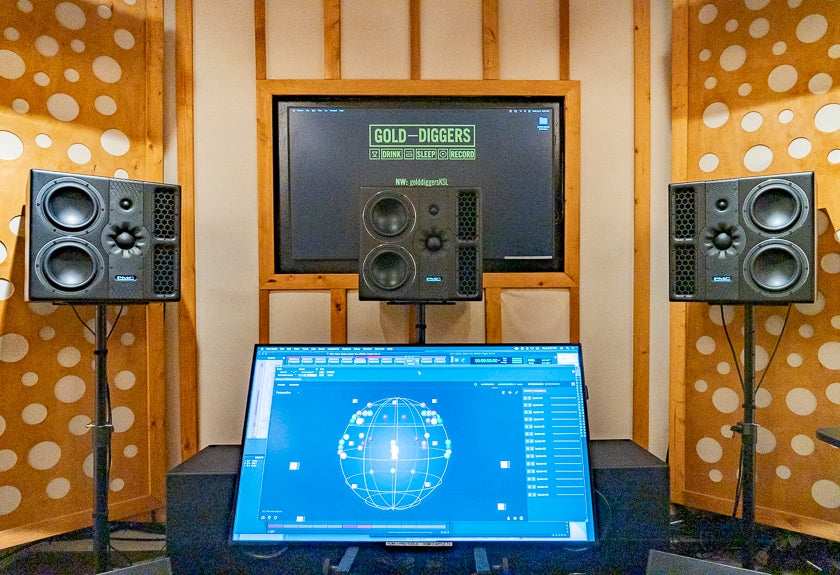
The computer display in Gold-Diggers showing the location of audio sources in the studio. The software is 360 WalkMix Creator developed by Audio Futures, that can be used with most digital audio workstations.
Keep in mind, when you have a set of speakers located just under your spine on each side of your body, just below your rear end, along with all those other speakers in the room it’s pretty tough to duplicate, but the immersive quality heard through headphones was lovely and believable. Of equal importance is that the 360 Reality Audio system doesn’t require any specialized equipment for headphone listening; you do need to download an app from a compatible streaming service, and listen to content created using 360 Reality Audio. This is unlike those surround headphones with multiple drivers, all connected separately to receive discrete signals and reproduce separate audio channels. The Sony 360 Reality Audio system was meant for your phone, on the go, anywhere you want to listen to music, though there are some compatible speakers available.
The goals of the system are ambitious. For example, by using the camera in your phone, the core technology can generate a personalized HRTF (head-related transfer function) “easily and quickly” from a photo of your ear. HRTF determines how an ear receives sound from a point in space (according to Wikipedia), and is unique to each person. For more information about 360 Reality Audio, click here.
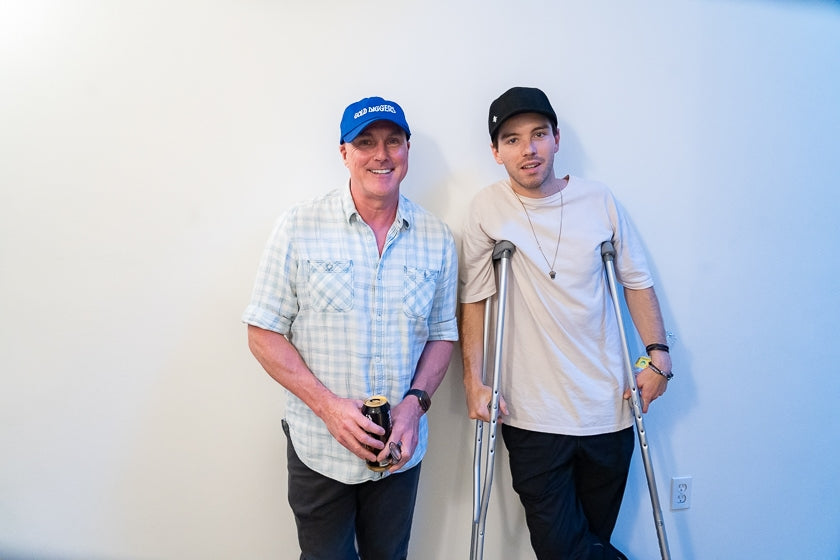
Gold-Diggers’Simon Horrocks, and Ross Caravati of Sony, during the Sony 360 Reality Audio demonstrations.
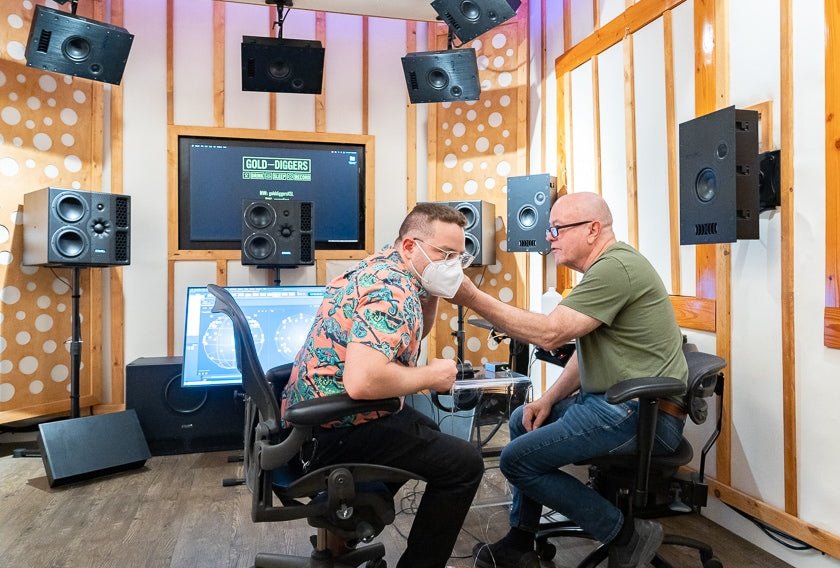
Gus Skinas fitting Mac Edition Radio’s Thomas Fogel with positioning microphones. Thomas then faced the speakers, and the microphones calibrated the system to his precise location. Later the microphones are removed and replaced with headphones.
It was also a treat to be in a sparkling new recording studio, though not everything was new, as Gold-Diggers held stacks of vintage amps, guitars, and more; a heady environment. Food was prepared by a pop-up team that made fantastic sliders, chicken, fresh onion rings, and more. The stress of midtown Los Angeles traffic melted away. For my son Thomas it was the perfect introduction to NAMM, without all the show floor hustle and bustle, and an opportunity for all of us to see how and where music is created. How the public will respond to 360 Reality Audio is anybody’s guess, but with Sony’s backing I think we’ll hear more about it in the future.
All the main NAMM exhibition halls were filled with every conceivable variety of music, studio and pro audio gear, from stalwarts like Shure, Korg, Ludwig, Moog, and Fender to small one-person companies. As noted in Part One of this report, there were a number of exhibitors that audiophiles would recognize. Chord was there showing off their latest DACs and amplifiers, including their Ultima 3 mono power amplifier, and acclaimed Mojo 2 portable DAC/headphone amp. The packed Audeze booth was a few aisles away. With the help of public relations expert Ari Morguelan guiding me around the booth, and company founders Sankar Thiagasmudram and Mark Cohen, Audeze introduced their $1,699 MM-500 planar magnetic headphones. The MM-500 was voiced by Grammy-winning producer Manny Marroquin. I didn’t have a chance to seriously listen to the headphones, but hope to in the near future.

Tom Vaughn of Chord Electronics with the pro market version of their Ultima 3 amplifier.

Ever wonder who created Audeze headphones? It’s these two gents, Sankar Thiagasmudram and Mark Cohen.
IEMs (in-ear monitors) are a huge business with musicians (and some audiophiles), as they’ve become the standard for on-stage live concert use. Accordingly, the Etymotic/Westone booth was jumping, with folks getting ear molds made on the spot, and enjoying the ability to try and compare different models. One of the goals of exhibiting at NAMM isn’t just to meet with consumers, but also to organize business and sales meetings, and work with the press to spread the word about new products. Even I had some ear impressions made; now to follow-up on them!
Etymotic and Westone are two peas in a pod, actually, with Dr. Mead Killion, founder of Etymotic Research, now having enormous influence over both product lines. One difference between the two companies is that Killion was a firm believer in single-balanced-armature driver designs, as opposed to in-ears that use multiple balanced-armature drivers. His vision was that as one adds drivers, it adds issues with time-alignment and crossover design, along with additional expense and manufacturing complexity. That said, Westone has a plethora of models that incorporate multiple drivers (as do other vendors like Shure). Etymotic’s top-of-class ER4SR and ER4XR models are flagship earphones for many audiophiles, and rightly so. (The ER4SR is tuned for a flat “studio monitor” response; the ER4XR has increased bass.) I’ve known folks at both companies for a while, and it’s nice to see them under one tent.
Hearing protection was how Etymotic Research got its start. And hearing protection is very much in the news as we read about large class action suits against allegedly defective earplugs used by those who served in Afghanistan and elsewhere, with multitudes of veterans returning with hearing damage. Hearing protection comes in many types, including headsets, simple earplugs, and custom-molded units, and can be passive or have active noise reduction. Etymotic and others offer hearing protection at different levels of attenuation through the use of removable filters.
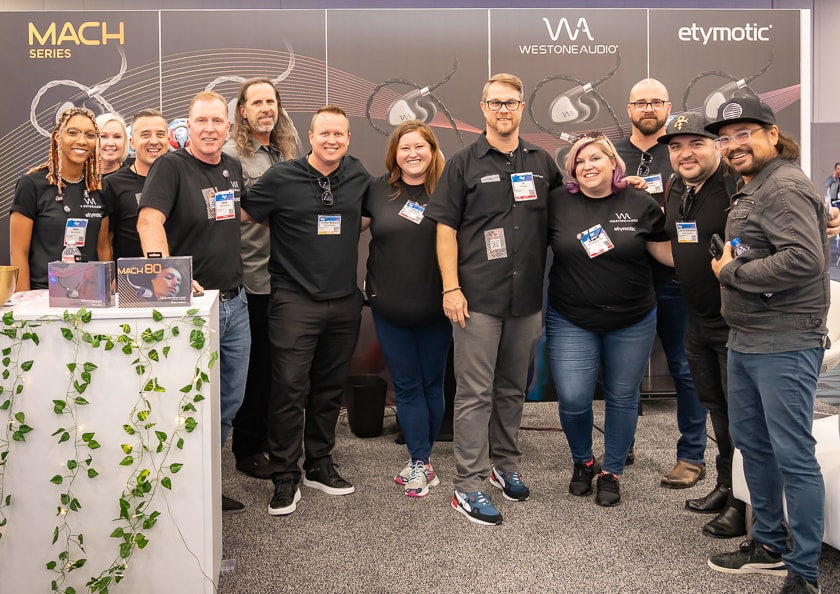
Etymotic Research and Westone Audio had one of the most popular booths, with ear molds being made for attendees every 20 minutes. Baile Johnson, Catherine Davis, Jeff LaRico, Steve Kearney, Tommy Roalson, Amanda Spencer, Tal Kocen, Rachelle Winnson, Drew Walters, Jacob Gonzales, and others were just part of the team on hand.
What does this have to do with audiophiles, you might ask? Many current IEMs are refinements of Killion’s designs, which arose out of products made for hearing protection – he had training as an audiologist and as a classical musician. (As an aside, I remember the first time I tried Sennheiser headphones that had the large yellow foam cushions. I was working at my college radio station, KHSU, and was getting headaches from wearing Koss Pro-4AA closed-back headphones, which were clamping on my head. Someone brought the lightweight, comfortable Sennheisers in, and I think it’s safe to say they changed our relationship to headphones forever.)
NAMM is a place where thousands upon thousands of people are trying out amplifiers, headphones, headphone amps and DACs, speakers, digital recorders, consoles, cables, and more (along with musical instruments, of course), but in a dual capacity: evaluating them not only for listening to reproduced music, but also in creating the recordings. Many attendees are professionally involved in the music creation process, and are keenly aware of neutral versus colored products and systems. It’s quite amazing to hear folks audition microphones and hear the sometimes subtle but often distinct differences they make. It’s pretty cool to experience a set of small studio monitors, and a few booths away, stare up at some twenty-foot-high stacks used in a concert setting.
NAMM is an industry-only event, but isn’t always so difficult to get a pass, since many manufacturers offer them to attract potential customers. If you are a musician, you will have a blast, as will anyone involved in component design, engineering, or post-production. In addition to the exhibits, there are many on-site and streaming seminars and more: at the 2022 show there were more than 260 educational sessions. While most of these are aimed at established and emerging professionals from all aspects of music production and performance, serious audiophile would also find much to learn about.
One of my favorite events was the annual loudspeaker competition, where the audience got to vote for their favorite speakers. Oh, I should mention, this wasn’t like sitting in an audio salon and auditioning a pair of bookshelves – the competition was between large pro-audio systems used for concerts. I couldn’t stick around for the outcome, but it was fun to see how seriously everyone took the listening and judging, using listening criteria that would not be unfamiliar to audiophiles.
It’s important for us audiophiles to remember that this is where our hobby begins, with musicians, instruments, and the recording chain, and with mixing and mastering technology, all in the hands of engineers, producers, and other experts. NAMM makes it all visible in one place, and it’s marvelous and inspiring.
Here are more show highlights:

Dave Trumfio of Gold-Diggers, and other folks enjoying a drink during the Sony 360 Reality Audio demonstrations.

Gus Skinas and Hiroyuki (Hiro) Komuro of Sony at Gold-Diggers Studio. If you have listened to and believe in DSD, you owe a lot of it to Gus.
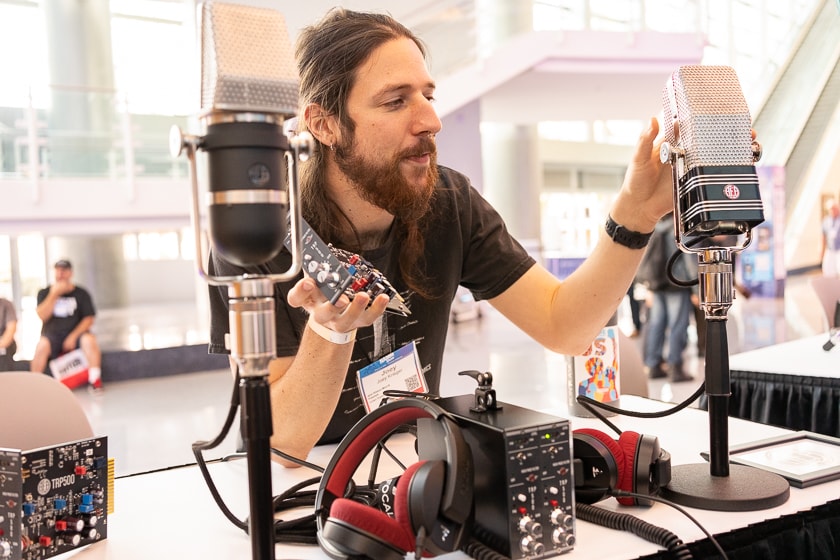
Joey Krieger of AEA Ribbon Mics & Preamps discussing the features of some new products.

The Disney-authorized Haunted Mansion Guitar, and Marc Minarik from Minarik Guitars at the NAMM Media Preview Day.
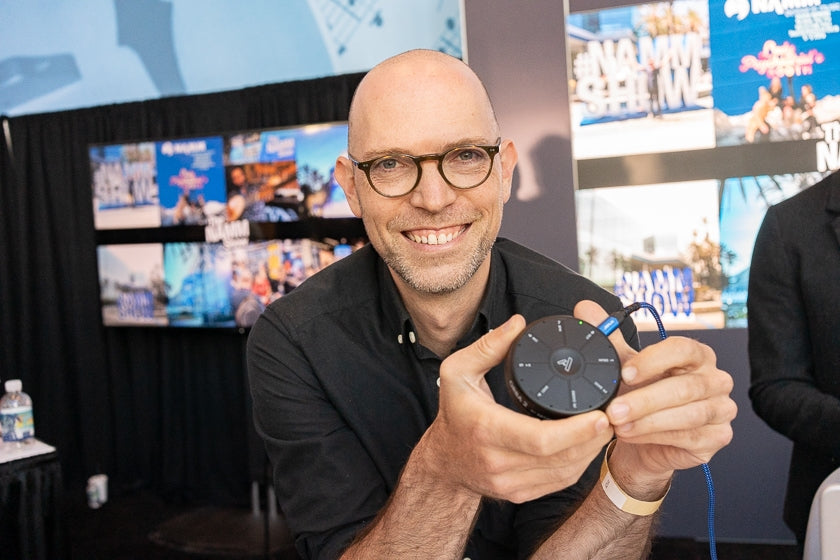
The Artiphon Orba 2 portable synthesizer is held by Mike Butera, founder and CEO.

Focusrite had some wonderful new tools for podcasting. Here, John DiNicola and Hannah Bliss show off their new line of Vocaster products.

The fine gents of Winkler Woods, showing off their stock of hand-picked specialty woods for sale to instrument makers.
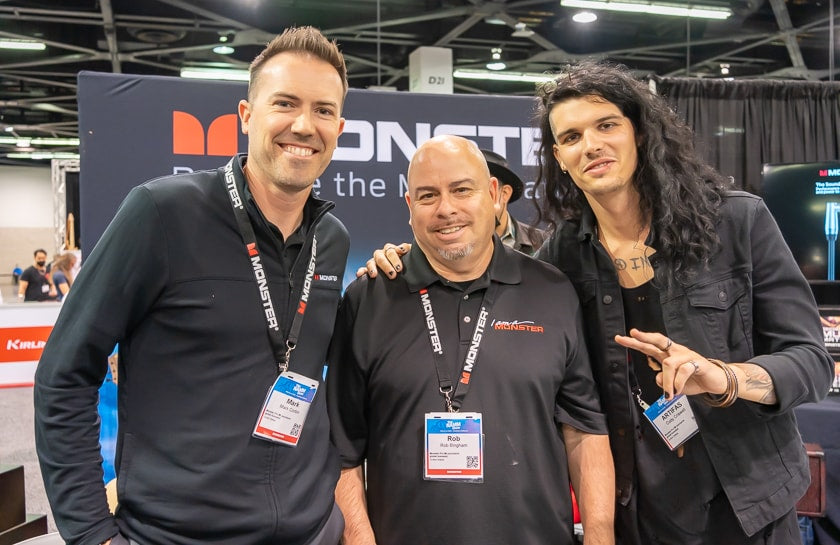
Mark Corbin, Rob Bingham, and Cody Criswell of cable and accessories manufacturer Monster.

Freddie Gateley, Finley Smith and Cash Gateley of VocalBooth showing off their portable sound isolation booth. My wife Nancy suggested that I get one and use it when testing open-backed headphones. She also doesn’t appreciate my singing or humming either.

Sophia Samons and Daniel Shinall of Thunderbolt Audio. Their Little Wedgie is a rubber wedge to keep onstage monitors at the right angle.
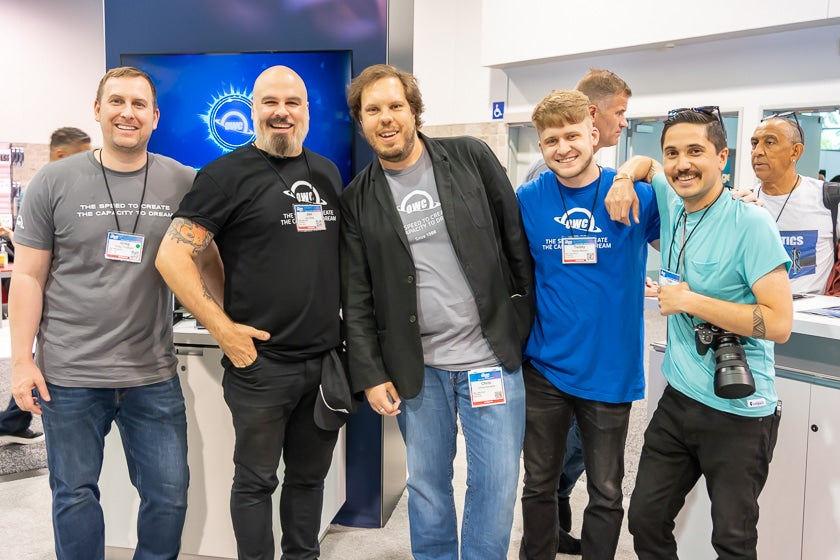
Many audiophiles utilize media storage products from Other World Computing (OWC), and here is the team behind the company: Greg Threlkeld, Jon Hoeg, Chris Kooistra, Teddy Mazrin, and Tyler King.

Officer Edgar, Officer Alvarez, and Sergeant McAlpine, three fine members of the Anaheim Police Department officers who kept the peace, while grooving to the tunes. I can certainly think of worse assignments!

The Donner company shows off several new affordable instruments. utilizing composite materials. Here Jake Qijie Wu of Donner, holds a violin while Mac Thomas Fogel holds their latest carbon fiber guitar and PR person Ari Morguelan keeps the party in check.
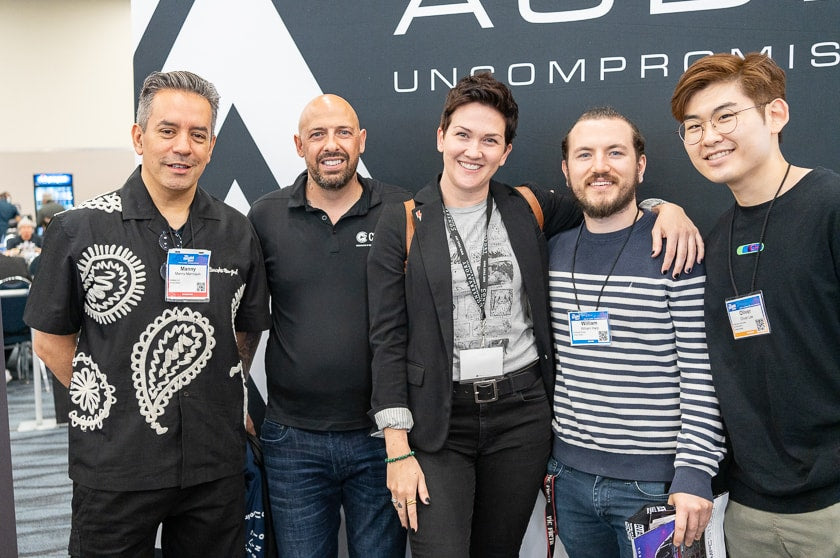
Audeze was featuring the new MM-500 Series planar magnetic headphones, designed and voiced by Manny Marroquin, and it seemed that everyone wanted to meet him. Here some visiting students and faculty pay him a visit.

The Antares booth, either the savior or the enemy of music, depending on your view about Auto-Tune.

Hiroyuki Komuro is one of key engineers at Sony, involved with Sony 360 Reality Audio among other achievements.
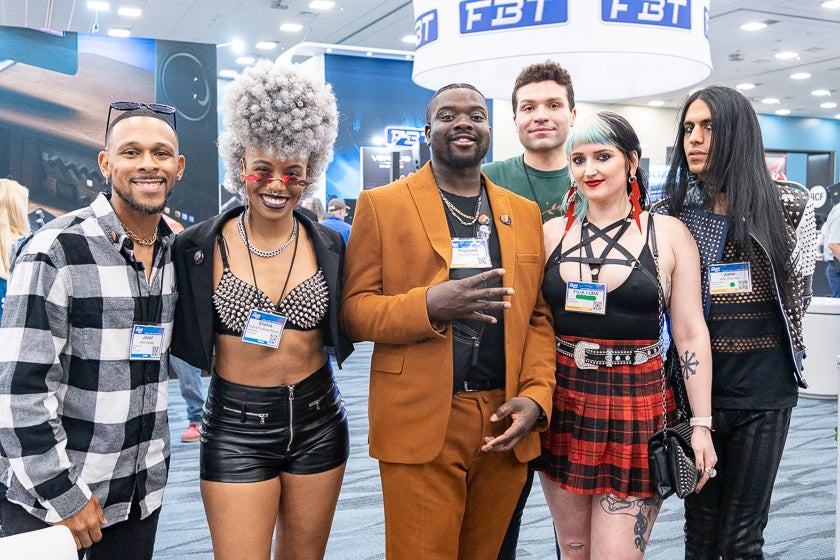
Getting yourself noticed is a common goal for many musicians who were attendees. Jared Baisley, Elishia Florence-Baisley, Reginald Bailey, Filia Luna, and John Polimeni did just that!

Shingo Dobkin, Dylan Scarzafava, and Phillip Walker at the Dekoni Audio booth. Dekoni, vendors of high-quality headphones, IEM tips, cases and other products, were a popular booth at NAMM I’ve tested many of their products and can attest to their quality.

Byllee Kairy and Justin Howard of Pole Hugger Music. Their Pole Hugger is designed to fix a nagging issue for musicians: where to put your headphones while in a studio or onstage. Might be handy for audiophiles also.

Fred Armisen delivers the opening monologue at the 2022 NAMM TEC Awards. The awards honor achievements in music, technology, engineering, and other categories.
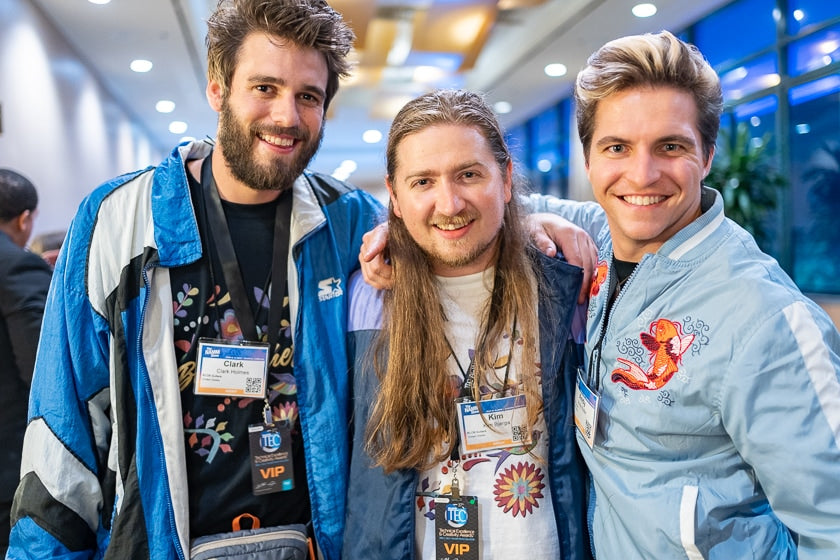
Clark Holmes, Kim Bjerga and Andy Nufer, of KLŌS Guitars, Provo, Utah, Their band, The Birdwatchers, was featured at NAMM, where they played the firm’s carbon fiber instruments.
Header image: it’s not uncommon that folks like Joe Lamond, President and CEO of NAMM and drummer, are also serious players. Here he is sitting in on the drums with the band Printz during a gig at the Hilton Hotel. Most hotel bars feature a house band, but during NAMM, the abundance of talent is amazing.













0 comments